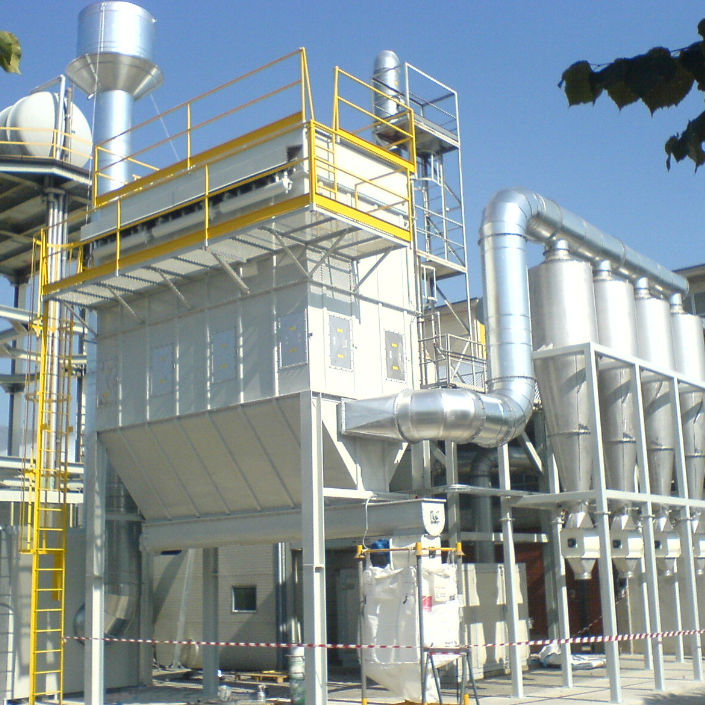DUST REMOVAL
Fabric filter, dust collectors, often called baghouses, are the most widely used type of equipment for separating particles from dry gas streams.
All types of fabric filter collectors are similar in the sense that the dirty gas stream is drawn through a cloth medium which arrests the particulates and allows only cleaned gas to pass through. The functioning of the fabric filter can be resumed as follow: the dust-bearing gas is passed unidirectionally through a fabric in such a manner that the dust particles are retained on the upstream or dirty gas side of the fabric, while the cleaned gas passes through the fabric to the downstream or clean gas side, whence it is removed by natural and/or mechanical means. Filter fabrics have the ability to catch particles smaller than the smallest opening in the cloth, so obviously there is more to the mechanics of dust collection on cloth than simple sieving. Although the open spaces between the fibers of the cloth may measure 100 µm or more, the material can, after seasoning, trap particles smaller than 1 µm. During the operation, particles are retained on the cloth fibers by different mechanism: sieving, interception, impingement, diffusion, gravitational settling, and electrostatic attraction. These forces will hold enough particles to the cloth fibers to form a filter cake or mat which will then accomplish filtration by finer sieving as well as by previously mentioned mechanisms. To prevent excessive pressure drops as the particulate accumulates, these devices use various mechanisms to disengage the particulate from the medium.
Fabric filter are manufactured to handle airflows ranging from a few to several thousands of cubic meters per hour. While large units are designed and engineered for each individual application, there are many applications suitable for small pre-engineered, “mass-produced units.”
All fabric filter media are manufactured from yarn—a generic term for continuous strands of fibers, filaments, or other materials which are suitable for knitting, weaving, or otherwise entwining to form a textile fabric. The basic structural unit of yarn is the fiber. Materials that can be used for the construction of the fabrics are: cotton, wool or man-made fibers (e.g., acrylics, polypropylene, polyesters, Teflon, …). Many fabrics are chemically and mechanically treated after manufacture to aid the filtration process. They can be treated with silicon to give them better cake release properties or treated with flame retardants. Obviously, the material chosen for the construction of the fabrics depend by the air flow chemical-physical characteristics. Developments in fabric technology enable baghouses to cope with temperatures in the range of 300 ° C, and to resist corrosive, acidic, and alkaline gases. Dust concentrations handled can range from very light, as is the case in atmospheric air, to very heavy for pneumatic conveying.
Fabric filters can be classified on the basis of:
- types of fabric filters (the most common used are tubular and the envelope shapes)
- methods used for cleaning the media (e.g., shakers, reverse-flow, Hersey-type or blow-ring, and pulse-jet).
Each type has a particular combination of advantages and disadvantages.
The use of fabric filters constitutes one of the more costly methods of dust collection, but this is offset by high efficiency and fabric filtration’s ability to meet most stringent particulate emission codes. Costs for capital equipment vary depending on application and maintenance costs are ap priceable because filter media must be replaced regularly during the life of the collector.
Fabric filters are generally not used where the particulate is combustible or where the product is to be sent back to the process and wetted. For the latter, it is easier to simply use a wet scrubber.
Filters can operate continuously or intermittently.
ADVANTAGES
This system is an optimum compromise between footprint and pollutants removal efficiency. Removal yields are very high; in some cases, a removal efficiency up to 99.9% can be reached.
BOUNDARY CONDITIONS / DESIGN PARAMETERS
Fabric filter performance can be affected by the conditions that the fabric is exposed to and the frequency of cleaning. Minimum operating temperature is especially important where acid gases are expected to be present in the gas stream. Lower temperatures mean acid gases have the potential to condense and corrode the fabric filter casing and other metal parts. Condensation can also cause bag blinding, which blocks air flow through the bag. Fabric filters are also susceptible to damage caused by high temperatures.
APPLICATIONS AND PERFORMANCES
Fabric filters are used in several industrial sectors as: chemical industries, cement plants, wood industries, steel and glass industries, coal treatment and combustion plants, and, sometimes, even in solid wastes treatment plants (e.g., incinerators, compost plants, sewage treatment plants, …).
Fabric filters can provide above 99 percent efficiency for removal of particles larger than 1 µm. Filtering velocities usually vary from 0.5 to 6 m/min. An operating pressure drop of 50 to 250 mm water gauge is standard for most fabric filter in order to save fan horsepower but some collectors can run at substantially higher or lower pressure drops.
ENERGY CONSUMPTION
Energy consumption depends on fan’s power, which are chosen according to the site conditions (e.g., ducts length and diameter). In addition, this system provides use of compressed air that can have a remarkable impact on the cost as well as the cooling/heating system, if necessary. Further energy saving potential can be tapped by the fluid dynamic optimization of the overall system. Further energy saving potential can be tapped by the fluid dynamic optimization of the overall system. The selection of the filter media in combination with a periodic cleaning of the system are crucial issues to reduce energy requirements.
ENVIRONMENTAL FEATURES
Exhaust filters and captured materials have to be disposed of.
RELATED PRODUCTS
- filtering materials
- air compressor
- electro-mechanical equipment.


 @airqualitymaker.com
@airqualitymaker.com @airqualitymaker.com
@airqualitymaker.com